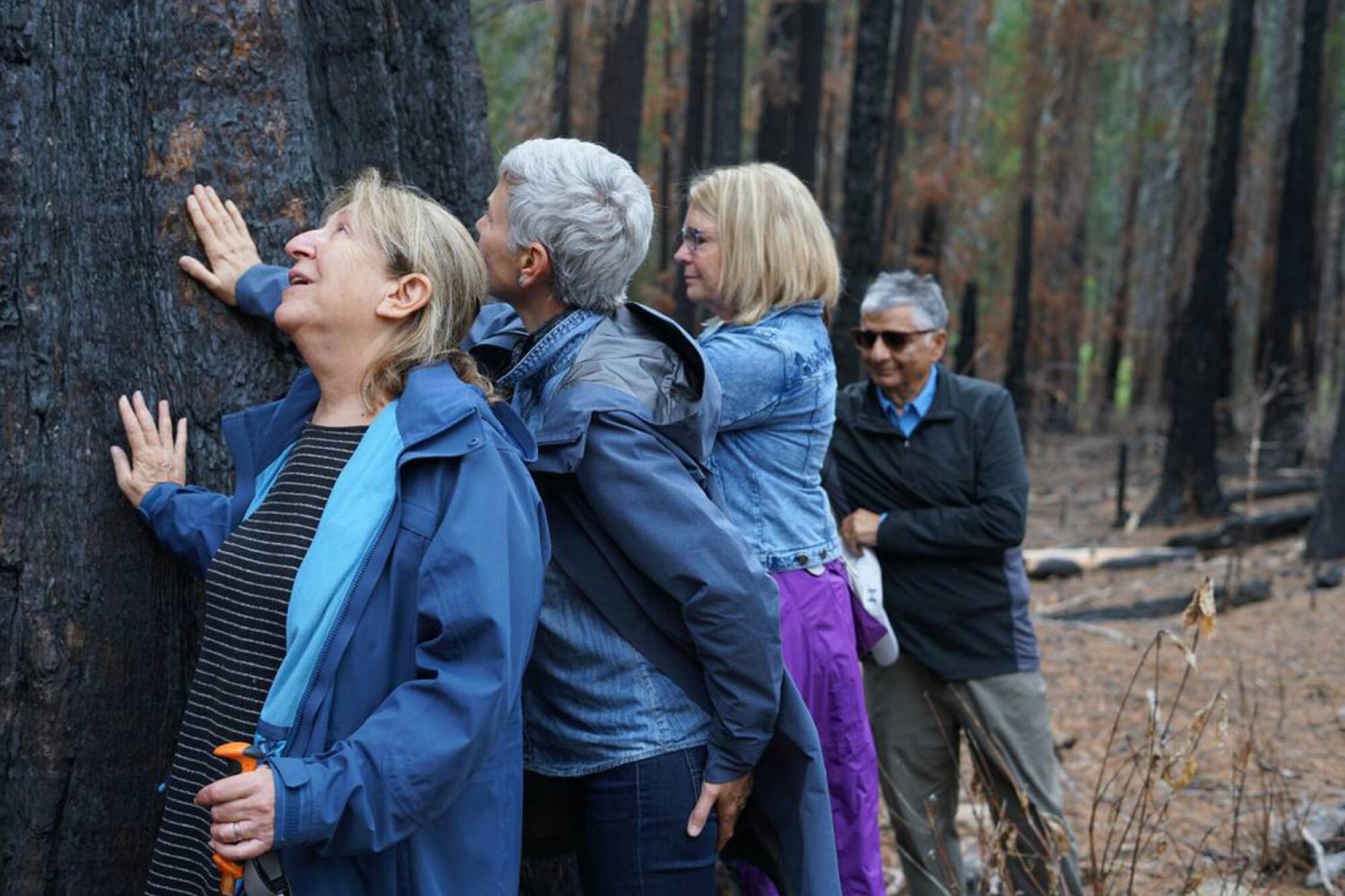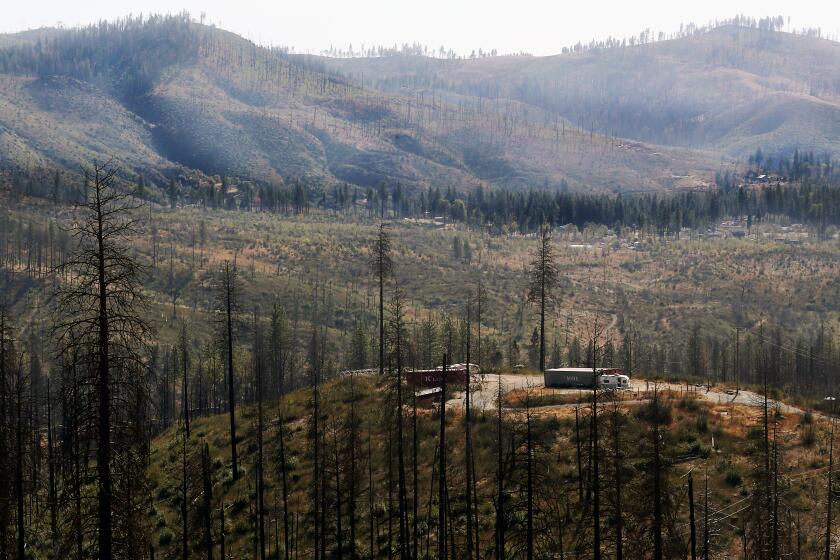
- Share via
Two beloved giant sequoias scorched in a prescribed burn at Calaveras Big Trees State Park last year now appear likely to recover.
The damage to the ancient trees — named the Orphans — had drawn outrage from some members of the Northern California mountain communities that surround the park, who accused staff of failing to adequately prepare the forest before setting it alight. Officials said they took the proper precautions but that the trees appeared to have been weakened by years of drought, making them more susceptible to a pulse of heat that roasted their massive trunks and killed much of their canopies.
In October, a team of experts hiked to the Orphans to examine them. Both had plenty of green in their crowns and had regrown foliage since the fire, said Kristen Shive, a fire ecologist and assistant professor at UC Berkeley who has studied how much crown damage giant sequoias can sustain.
“I saw two very happy living trees,” she said. “I expect both of them to survive.”
The Orphans, which are at least 500 years old, got their names because they are set apart from other sequoias in the grove. The broccoli-topped giants have long towered over the smaller trees that surround them.
Aggressive and impactful reporting on climate change, the environment, health and science.
But the burn that took place last October and November, which was intended to cull vegetation that could fuel a damaging wildfire, blackened their enormous copper-colored trunks and turned most of their green tops brown.
Still, the burn achieved a key goal: regeneration, said Danielle Gerhart, district superintendent of California State Parks’ Central Valley District. Giant sequoias rely on fire to reproduce — their cones open and release seeds only in response to bursts of heat, and flames expose mineral soil in which those seeds can germinate.

As a result of the prescribed burn, thousands of sequoia seedlings are growing beneath the Orphans, Gerhart said. Many will eventually perish as they compete for sunlight and water, but a few might grow into the next crop of monarchs.
“We have to have fire that’s hot enough to be able to create that regeneration, and that to me is really exciting,” she said. “It literally is a carpet of green underneath and they’re all little babies.”
Calaveras Big Trees is a haven for local residents, who describe a spiritual connection to the park’s cathedral-like sequoia groves. As the state’s longest continually running tourist attraction, it also serves as the area’s economic engine.
Marcie Powers, former board member of the Calaveras Big Trees Assn., a nonprofit that raises funds for the park’s educational and interpretive programs, said she was thrilled to see new growth. She described the contrast between the trees’ baked crowns and fresh greenery as “stark and stunning.”
One-fifth of all conifer forests in the Sierra are mismatched with the warmer climate and may not survive, according to Stanford University researchers.
After the Orphans were damaged, Powers resigned from the board to found Save Calaveras Big Trees with her husband. The group’s goal is to get the park to do more thinning, mastication and biomass removal, which they hope will reduce the risk of sequoias dying in both prescribed burns and wildfires.
Powers pointed out that the long-term survival of the Orphans is not certain, as the fire weakened the trees and could still result in them succumbing to drought or beetle attacks in the years to come. She said the burn also killed some juvenile giant sequoias between 10 and 40 years old.
“I still feel that had they been more vigilant, they might not have had such severe damage to the Orphans or to the dozen adolescent giant sequoias around them that were outright killed,” she said. “Only a few seedlings will make it to become monarchs, which is why it’s important to protect the ones we have.”
Before the burn, crews raked leaves and needles away from the Orphans’ roots and cleared heavy vegetation and downed limbs within a 20-foot radius of their trunks, Gerhart said. Still, she said, it’s impossible to prepare the forest to the point where a prescribed fire carries no risk of mortality.
“As much as none of us want that to happen, it is still a possibility,” she said. “Fire is not an exact science.”
Even so, when any tree dies — including a giant sequoia — that reduces competition for resources, allowing other trees to thrive, she said.
Crews recently planted 30,000 giant sequoia seedlings in the western Sierra, as part of an ongoing effort to restore groves devastated by wildfire.
“I think the key is we have to start thinking about these as dynamic ecosystems again, rather than as museum pieces, where we naively think we can keep every single one of them around forever,” Shive said.
She and other giant sequoia experts have watched the debate playing out between local residents and park officials with trepidation, fearing the backlash to the burn could jeopardize efforts to safeguard other ancient groves.
Giant sequoias grow naturally only in a 60-mile band of forest on the western slopes of the Sierra Nevada. Though they need fire to thrive, they are no match for the massive, high-severity wildfires that have become more common over the last decade, scientists say. Nearly 20% of the giants’ population are estimated to have died in just three fires in the southern Sierra in 2020 and 2021.
Experts blame a combination of climate change, the dispossession of Indigenous people who once stewarded the land and management decisions like aggressive fire suppression and industrial logging for creating denser, more flammable forests in the Sierra.
These conditions are capable of stoking hotter, faster-moving fires that can race up into the crowns of sequoias, incinerating the massive trees. Without action to restore these lands to something more closely resembling their precolonial conditions, many more sequoias will be lost, the experts fear.
“Part of how these forests evolved is with fire. By us excluding it all this time, we’ve created such a horrendous problem that a lot of trees are dying,” said Brent Skaggs, a contractor with the nonprofit Fire Restoration group.
“We need to own up to that and take steps to restore fire back in these ecosystems,” said Skaggs, a retired Forest Service fire management officer for the Sequoia National Forest and Giant Sequoia National Monument.
He acknowledged that even the most careful prescribed fire could kill some mature giant sequoias. But on balance, the practice is key to protecting the trees that remain from catastrophic wildfires that will wipe out much larger numbers, he said.
“Folks love the Orphans,” he said. “I understand that — I love sequoias myself. There’s a worry, though, that if you don’t allow the natural process to occur because you love them so much, you’re going to love them to death.”
Since the controversy, Calaveras Big Trees State Park has moved ahead with more prescribed burns, including a 39-acre one in the park’s North Grove last month that appears to have gone as planned, Gerhart said. A much larger, 1,300-acre burn is planned for the South Grove this fall. Officials had hoped to ignite it this week, but the area is still too wet from recent rains.
Crews have been preparing for over a year by clearing vegetation away from the bases of giant sequoias, thinning and masticating smaller trees, hauling off large logs and reducing the amount of vegetation around a road that surrounds the burn area, Gerhart said.
The uproar has redoubled the park’s commitment to transparency and public education, she added.
“I think it just reminded us that the community cares so much and we are responsible for what’s going on in the park and we want to share that with people,” she said. “We’re all here together. We all live in this community.”












